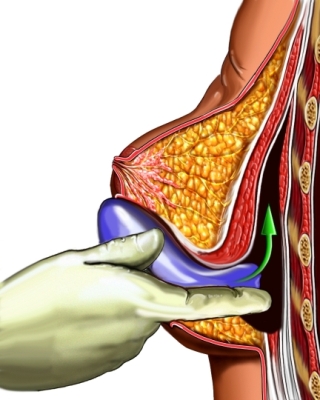Breast Augmentation – plastic surgery to increase the breast
Description breast augmentation surgery
Breast Augmentation – operation to increase the size or change the shape of the breast.
Reasons for breast enlargement surgery
- Cosmetic causes – to enlarge breast size, make breasts symmetric, or improve the shape and / or contour of the breast;
- Restorative reasons – to increase your breast size, that has been damaged or operated (eg, after mastectomy for breast cancer).
Possible complications with an increase in breast size
Complications are rare, but no operation ensures no risk. Before, how to perform the operation, you need to know about possible complications, which may include:
- Bleeding;
- Infection;
- Pain;
- Abnormal Scarring;
- Soreness and / or restricted arm and shoulder motion;
- Uneven breast growth;
- The implant may solidify, rupture or deflate;
- The implant may complicate diagnosis of cancer (through mammogram and / or self-exam);
- Reduced sensitivity of breast;
- The need for a large number of operations, including the removal of the implants.
Factors, that may increase the risk of complications:
- Smoking.
In the presence of disease or ill health to perform the procedure is not recommended.
Silicone implants, disposable chest, not designed for prolonged wearing. Usually, they must be removed during the 10 years. The risk of complications increases with the aging of the implants.
How is breast augmentation surgery?
Preparing for Surgery
The patient may ask, chest a woman should look like her own after surgery. It may also be asked to review an album of breast sizes and shapes, to help determine the final result.
Your doctor may do the following tests:
- Perform a physical exam, including a thorough examination of the breast;
- Order blood tests and urine tests;
- Run electrocardiogram – test, that records heart activity by measuring electrical current, passing through the heart muscle;
- Conduct mammography;
- Order a chest radiograph;
- Make breast pictures “to” operations.
Operated may be asked to stop taking some medications or supplements for one week before the procedure:
- Aspirin or other anti-inflammatory drugs;
- Blood thinners, such as warfarin, clopidogrel;
- Ginkgo biloba or other herbal supplements.
Before the procedure
- On the eve of the operation in the evening you can eat a light meal. Do not eat or drink anything after midnight;
- The patient may be asked to take a shower with antibacterial soap in the morning of the procedure;
- We need to organize a trip to and from the procedure;
- It is necessary to organize care at home after returning from the hospital.
Anesthesia
When the operation is commonly used general anesthesia. During the operation, the patient is asleep. In some cases, it can be used local anesthesia.
Description of the procedure of breast augmentation
The skin incision may be made in the following areas: under the breast, near areoles (pigmented area around the nipple), armpits, or navel. Through this incision will put the implant, which may comprise silicone gel, or will be filled with salt water (brine). The implant can be placed between the skin / breast tissue and muscles, under the fascia (connective tissue of muscles), directly or submuscular. Around the implant can be installed drainage tube. The incision is closed with stitches and bandaged. A similar procedure may be performed for the other breast.

How long does the surgery?
Operation takes one to two hours.
Will it hurt?
Anesthesia will prevent pain during surgery. To facilitate postoperative pain patient administered painkillers. The patient may be bruised and sore breasts for several weeks after surgery.
The time spent in hospital
Most often, you can leave the hospital the day of surgery.
Postoperative care after surgery for breast augmentation
- The patient is recommended to wear a special bra or bandage, to put pressure on the chest. This will help support the breast and reduce the likelihood of bleeding;
- To reduce the swelling and pain in the chest can be used ice packs. It is necessary to wrap the ice in a towel. You can not apply ice directly to the skin;
- Patients may be given a prescription for pain medicine or recommend taking acetaminophen or ibuprofen;
- It is necessary to carry out the exercises razvivyuschie;
- Your doctor may recommend a massage to perform the implant;
- We need to ask the doctor about, when it is safe to shower, bathe or expose the surgical site to water.
Since silicone implants thickens, you must pass MRI, To test for discontinuities or openings in the implant. Examinations, usually, made three years after the operation and every two years thereafter.
It is necessary to go to the hospital in the following cases
- There are signs of infection, including fever and chills;
- Saved fever;
- Redness, edema, increased pain, bleeding or discharge at the incision site;
- The accumulation of fluid or blood breast;
- Nausea and / or vomiting, that persist for more than two days after discharge from the hospital;
- Inability to relieve pain using painkillers;
- There was a sense of rupture of implants;
- Cough, shortness of breath or chest pain;
- Pain and / or swelling in the legs, ykrah, feet;
- Joint pain, fatigue, constraint, rash or other symptoms.
